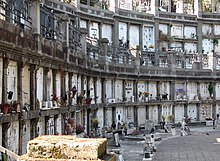Sliding grave


A sliding grave or oven grave is a wall niche in an above or underground burial facility, into which a coffin or a corpse can be pushed lengthways (oven grave) or parallel to the wall. Usually the niche is closed with a stone slab with an inscription. The shift grave in ancient hereby rock tombs and catacombs as an alternative to sarcophagi , trough graves and Arkosolgräbern on. The burial niches can be built individually, in groups or in regular batteries.
Sliding graves in Italy
Grave niches in the walls of above-ground grave complexes, which are regularly arranged next to and one above the other in rows, are widespread in Italian cemeteries. They are called Colombario there, but in contrast to a columbarium in the old Roman Empire or in today's Germany, they are not used for urns but for body burials. A single sliding grave in the niche battery is called Loculo. It has a slight slope towards the rear to collect the decomposition liquids and is impermeable to liquids and gases.
Sliding graves in Germany
Push graves are rather rare in Germany. In particular, graves in churches are usually set into the ground or have the shape of sarcophagi. The oven graves in the crypts of the Mainz churches of St. Christoph , St. Ignaz and St. Peter are an exception . They were laid out in the crypts of these churches due to lack of space in the inner-city cemeteries and were used from 1750 to 1803 - after that, burials in churches and inner-city cemeteries were banned by Napoleon's "Décret impérial sur les sépultures" in France and in the areas he occupied. There are also sliding graves, for example, in the Carmelite monastery on Kaulberg and in the Martinskirche in Bamberg .
Pushing graves in Palestine
Burial in caves was the common form of burial for the Israelites in early biblical times . In the 1st and 2nd centuries BC In Palestine, rooms carved into the rock with tunnel-shaped sliding graves, called kuchim (plural from Hebrew כוך = niche), dominated the simple family graves in Palestine.
Neolithic sliding graves
Oven graves (Italian tomba a forno, Italian / Sardinian forros) are also called the rock graves in Sardinia with egg-shaped mortuary chambers and rounded openings, which already existed in the Bono Ighinu culture . Such graves, which were found, for example, in Cuccuru S'Arriu , differ from the Domus de Janas (houses of the fairies) typical for Sardinia of the later Ozieri culture with a horizontal access through a vertical access shaft.
So-called niche graves
In some epochs (Roman times, early Middle Ages) graves with additional side niches were created. Often these grave niches contain grave goods . These burials are called niche graves in archeology . The niche graves differ from the sliding graves in that the niche itself usually does not contain any human remains.
literature
- Hans Fritzen: The building history of the St. Ignaz Church in Mainz (= contributions to the history of the city of Mainz. Vol. 22, Part 1, ISSN 0405-1998 ). City Library, Mainz 1974
- Hannelore Künzl: Jewish funerary art from antiquity to today. Scientific Book Society, Darmstadt 1999, ISBN 3-534-10691-1 .
Individual evidence
- ↑ "Aucune inhumation n'aura lieu dans les églises, temples, synagogues, hôpitaux, chapelles publiques, et généralement aucun des édifices clos et fermés où les citoyens se réunissent pour la célébration de leurs cultes, ni dans l'etence des bourgs. "